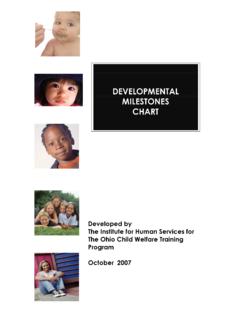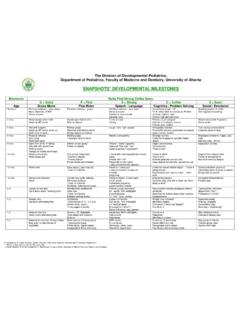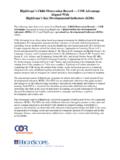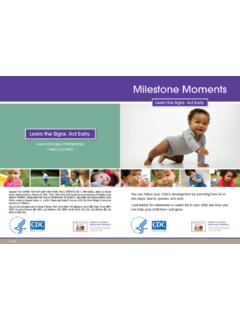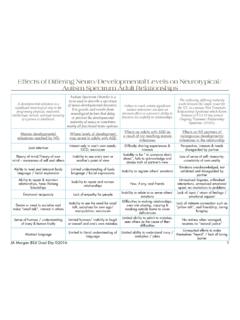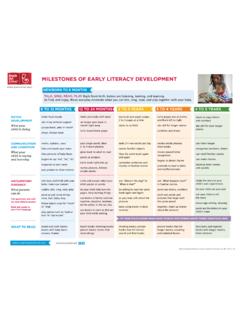Transcription of Cambridge Nationals in Child Development Unit 20 ...
1 Unit R020 Understand the Development of a Child from birth to five yearsDELIVERY GUIDEV ersion 1 Cambridge Nationals LEVEL 1/2 Child Nationals IN Child DEVELOPMENTLEVEL 1/2 UNIT R0202 CONTENTSI ntroduction 3 Related Activities 4 Key Terms 5 Misconceptions 6 Suggested Activities: Learning Outcome (LO1) 7 Understand the physical, intellectual and social developmental norms from birth to five years. Learning Outcome (LO2) 11 Understand the benefits of learning through play. Learning Outcome (LO3) 13 Be able to plan different play activities for a chosen developmental area with a Child from birth to five years.
2 Learning Outcome (LO4) 16 Be able to carry out and evaluate different play activities for a chosen developmental area with a Child from birth to five years. Cambridge Nationals IN Child DEVELOPMENTLEVEL 1/2 UNIT R02033 INTRODUCTIONThis Delivery Guide has been developed to provide practitioners with a variety of creative and practical ideas to support the delivery of this qualification. The Guide is a collection of lesson ideas with associated activities, which you may find helpful as you plan your lessons. OCR has collaborated with current practitioners to ensure that the ideas put forward in this Delivery Guide are practical, realistic and dynamic. The Guide is structured by learning outcome so you can see how each activity helps you cover the requirements of this unit.
3 We appreciate that practitioners are knowledgeable in relation to what works for them and their students. Therefore, the resources we have produced should not restrict or impact on practitioners creativity to deliver excellent learning opportunities. Whether you are an experienced practitioner or new to the sector, we hope you find something in this guide which will help you to deliver excellent learning opportunities. If you have any feedback on this Delivery Guide or suggestions for other resources you would like OCR to develop, please email OPPORTUNITIES FOR ENGLISH AND MATHS SKILLS DEVELOPMENTWe believe that being able to make good progress in English and maths is essential to students in both of these contexts and on a range of learning programmes.
4 To help you enable your studentss to progress in these subjects, we have signposted opportunities for English and maths skills practice within this resource. These suggestions are for guidance only. They are not designed to replace your own subject knowledge and expertise in deciding what is most appropriate for your students. English MathsPlease note The activities suggested in this Delivery Guide MUST NOT be used for assessment timings for the suggested activities in this Delivery Guide DO NOT relate to the Guided Learning Hours (GLHs) for this unit. Assessment guidance can be found within the Unit document available from The latest version of this Delivery Guide can be downloaded from the OCR R020: Understand the Development of a Child from birth to five yearsLO1 Understand the physical, intellectual and social Development norms from birth to five yearsLO2 Understand the benefits of learning through play LO3Be able to plan different play activities for a chosen developmental area with a Child from birth to five yearsLO4Be able to carry out and evaluate different play activities for a chosen developmental area with a Child from birth to five yearsTo find out more about this qualification please go to.
5 AIMThis unit will allow learners to investigate the developmental norms of children from birth to five years. Learners will develop an understanding of the impact of play on the developmental norms. On completion of this unit, learners will be able to apply their knowledge and understanding, through practical activities, to show how play affects the Development of individual children. Cambridge Nationals IN Child DEVELOPMENTLEVEL 1/2 UNIT R0204 This unit (Unit R020)Title of suggested activityOther units/LOsLO1 Introduction to developmentR018 Health and well-being for Child developmentLO3 Understand postnatal checks, postnatal provision and conditions for developmentLO1 Physical normsR018 Health and well-being for Child developmentLO3 Understand postnatal checks, postnatal provision and conditions for Development (Specifically reflexes).
6 LO1A family meal social Development ?R018 Health and well-being for Child developmentLO1 Understand reproduction and the roles and responsibilities of parenthoodLO3 Understand postnatal checks, postnatal provision and conditions for Development (Specifically conditions for Development , the need for acceptable patterns of behaviour and approaches to discipline socialisation).LO3 Playing SafelyR018 Health and well-being for Child developmentLO5 Know about Child safety(Specifically how to create a safe, Child friendly environment, safety labelling and to be aware of common childhood accidents).The suggested activities in this delivery guide have also been related to other units/learning outcomes (LOs) in this qualification.
7 This could help with delivery planning and enable students to cover multiple parts of ACTIVITIESCAMBRIDGE Nationals IN Child DEVELOPMENTLEVEL 1/2 UNIT R0205 KEY TERMSE xplanations of the key terms used within this unit, in the context of this unitKey termExplanationCentile chartUsed to plot the growth measurements (height and weight) of babies and children. This compares their growth to the standard norms to track their physical playPlay which takes account of others actions within their play playWhere children experiment with materials, music, is the process of learning new normsRecognised stages in patterns of is something that could cause harm. For example toys with sharp edges, or with small parts that could be developmentMeans the whole Child , seeing that all of the different aspects of Development interrelate to make each Child a unique developmentDevelopment of the mind, such as: learning to talk, understanding, memory, concentration, reasoning, problem solving, imagination, reading books, asking questions, telling stories, listening, and following the skills and abilities to be less dependent on playThis involves children using their hands, for example to move, turn or screw things to make them Skills that babies and children have mastered which are linked to age.
8 The idea being that the Child has reached a certain point in their skillsRefers to movement skills and abilities, there are two types of motor skills:Gross motor skills use and Development of the large muscle groups. Large movements involving the motor skills the small muscles used in precise movements involving hand-eye co-ordination. Sometimes referred to as manipulative skills. Small movements involving the process of watching accurately what is happening, watching how a Child developmentThe way in which the body increases in skill and playPlay that involves the muscles and moving around, such as football or a climbing growthThis refers to an increase in the body s Inborn, automatic movements.
9 Babies are born with primitive reflexes, (grasping, sucking, rooting, etc.) which protect them over the first few months of life and which then gradually playWhere a Child pretends to do or be something. For example driving a car or being a strategiesWays of reducing the risk or likelihood of danger, for example using round ended safety way a Child feels about developmentRefers to the growth of a Child s relationships with playWhere the Child plays alone, exploring and experimenting with Nationals IN Child DEVELOPMENTLEVEL 1/2 UNIT R0206 Some common misconceptions and guidance on how they could be overcomeWhat is the misconception?How can this be overcome?Resources which could helpTeachers teach each of the three units completely separately as if they were three standalone of unit R020 have relevance to content of unit R018.
10 These links are indicated in section one of this delivery guide. Learners should be encouraged to see the content as interrelated. The theory learned in unit R018 can inform practice in learners coursework tasks and vice Delivery Guide and the specification for each of the course units should be used to develop a thorough understanding of where links between unit content refer to the OCR Report to Centres for each assessment from: of Development occur at very specific all areas of Development there are stages that follow a recognised, regular, pattern but the age at which each stage occurs will vary. Tutors need to ensure that learners understand that norms and milestones reflect general patterns of Development and every Child is a unique individual.










